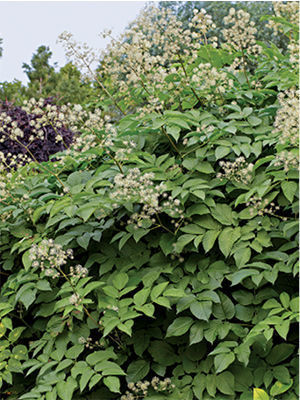1. Fairy Wings Epimedium

Name: Epimedium wushanense
USDA hardiness zones: 6 to 9
Size: Up to 2 feet tall and 3 feet wide
Conditions: Partial shade; fertile, moist, well-drained soil
Fairy wings epimedium is just now becoming more widely available. Each slowly spreading clump can reach 3 feet wide in as many years. The large leaves are evergreen in Zones 7 and warmer, reaching 2 or more feet long from base to tip. The 1-inch-wide cream-and-yellow flowers are held at or above the foliage, creating a pleasing contrast. Fairy wings epimedium is a tough customer for dry shade with root competition. Water it every few weeks, though, and add a generous layer of mulch to achieve the greatest size. Divide when clumps become congested to hasten its spread. In colder zones, treat this plant as a deciduous species and cut it back each year in early spring.
2. Hardy Foot Begonia

Name: Begonia pedatifida
Zones: 7 to 11
Size: Up to 18 inches tall and 30 inches wide
Conditions: Partial shade; humus-rich, moist, well-drained soil
This begonia is native to the mountains of southern China and is surprisingly cold hardy. It’s easy to grow in both sun and shade, but the leaves have an almost crystalline look if planted in dappled or full shade. Pale pink flowers top the foliage mid- to late season. All blooms disappear with the first hard frost, only to emerge again with the warming days of early spring. Keep the soil evenly damp with generous mulch for the most luxurious effect. Divide hardy foot begonia every three years or so, and place the thick rhizomes an inch or two under the soil when replanting, especially in cold climates.
3. ‘Spotty’ Cast-Iron Plant

Name: Aspidistra tonkinensis ‘Spotty’
Zones: 7 to 11
Size: Up to 3 feet tall and wide
Conditions: Full sun to partial shade; fertile, moist, well-drained soil
Once destined to reside in a dark corner in Auntie’s parlor, many new species and selections of cast-iron plant are now available from the gardens of eastern Asia. ‘Spotty’ flaunts yellow polka dots on its leaves, showing well even in deep shade. The narrow, upward-arching leaves have dark purple stems, so plant it near a contrasting ground cover, such as golden baby’s tears (Soleirolia soleirolii ‘Aurea’, Zones 10–11). ‘Spotty’ is surprisingly drought and shade tolerant, but in cool coastal areas, additional summer water hastens growth. One major flush of evergreen foliage can be expected each year, so keep the slugs and snails at bay while new leaves appear or their evidence will persist through the following season.
4. California Spikenard

Name: Aralia californica
Zones: 8 to 10
Size: Up to 10 feet tall and wide
Conditions: Full sun to full shade; humus-rich, moist soil
Native to damp ravines in California and Oregon, this plant is among the most tropical-looking natives around. California spikenard remains trunkless with leaves 3 or more feet long in deep shade. Deciduous, this plant has autumn color that is soft yellow, which contrasts well with the red fruit produced when several plants are in close proximity. Full shade keeps the leaves large, airy, and dramatic, while bright light creates dense clumps likely to flower more heavily. Divide the plant every two to three years, or grow it from seed as divisions can be slow to gain vigor.
Sean Hogan is the owner of Cistus Design Nursery on Sauvie Island near Portland, Oregon.
Photos: #1, Doreen Wynja; #2 and #3, courtesy of Cistus Design Nursery; #4, Visions/gapphotos.com

















Comments
Log in or create an account to post a comment.
Sign up Log in